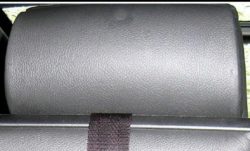The problem of head restraints (HRs) interfering with CR installation seems to be growing because HR design improvements for non-CR passengers can actually be at odds with CR installation ease. Injury reduction is more effective when the HR is closer to the back of the head, so the trend is for HR designs to protrude further into the seating area – sometimes preventing the back of a forward-facing CR from being aligned with the seatback. Unfortunately, this mismatch coincides with an increased use of high-weight harness (HWH) seats and higher-backed boosters, which are taller and much more likely to reach the height of the HR.
Upgrades to FMVSS 202, which will go into effect for MY 2011, will actually require these types of HRs that protrude closer to an occupant’s head, so incidents of the HR interfering with CRs may increase in the future. CPS advocates hope that automakers will respond with designs that can meet requirements and also avoid incompatibility with CRs. However, the standard does not include any compatibility test or language acknowledging a potential impact to CPS.
When dealing with an HR that interferes with CR installation, it is essential to refer to the CR and vehicle owner’s manuals. Both manuals may have specific advice regarding HR adjustment as well as tether strap routing. Generally, don’t make adjustments that are not suggested in the manual. Owners should follow up with the manufacturer if questions remain. Besides getting questions answered, the call also would provide the automaker with useful feedback that could influence future designs.
Guidelines for CPSTs and educators when helping caregivers with head restraints
- DO: Refer to the owner’s manual for the vehicle and the CR.
- DO: See if the HR can be adjusted upward into a locked position that is out of the way of the CR.
- DO: Consider removing the HR or rotating it rearward, if allowed by the manufacturer, when raising the HR is not possible or inadequate for positioning the CR. Be sure that the removed HR is stored securely so it will not be a flying object in a crash.
- DO: Strongly urge vehicle owners to reposition/replace an adjusted or removed HR if the seating position is used later for another passenger.
- DON’T: Move the HR to a position that is above or between locked positions.
- DON’T: Reinsert the HR backwards, unless specifically allowed by the automaker. In some cases the HR will not lock when reversed, and in a few cases the HR, once inserted backwards, cannot be removed without expensive assistance from the dealer. Due to new awareness of these potential problems when HRs are turned backwards, this advice supersedes any prior statements made in SRN or elsewhere regarding reversal of the HR.

